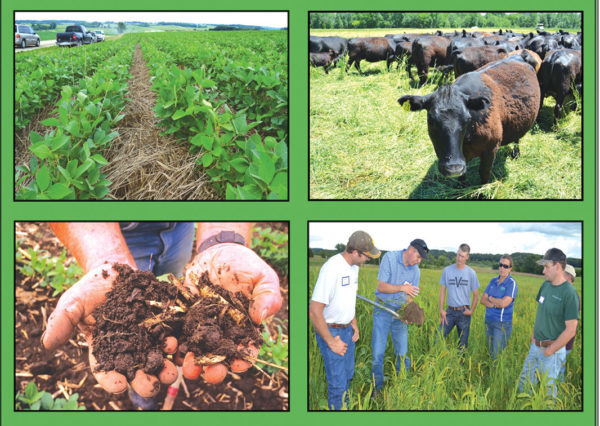
Editor’s Note: This is a guest post by Brian DeVore of the Land Stewardship Project (LSP), a National Sustainable Agriculture Coalition member organization. Brian manages media and communications for LSP, and is the author of “Soil Health, Water & Climate Change: A Pocket Guide to What You Need to Know“.
At a time of skyrocketing water pollution levels and increasing climate-related calamities, a new resource released this fall describes how farmers in the Midwest can play a key role in helping fix these serious environmental problems. The Land Stewardship Project’s (LSP) “Soil Health, Water & Climate Change: A Pocket Guide to What You Need to Know” provides an introduction to the latest innovations in science and farming related to building soil health, and details how implementing such practices on a wide-scale can turn agriculture into a powerful force for climate change adaptation and mitigation.
This innovative pocket guide includes profiles of farmers throughout the Midwest who are utilizing cover cropping, managed rotational grazing of livestock, no-till, and other methods to protect and build their soil from top to bottom.
The key to success for the farmers featured in LSP’s guide has been their ability to leverage the health of their soil to sequester an immense amount of carbon while also increasing their land’s ability to efficiently manage precipitation and runoff. It turns out that the twin problems of polluted water and climate change share a common solution: building the soil’s organic matter. Organic matter makes up just 5 percent of the soil profile, but it determines 90 percent of its functions. Healthy soil doesn’t happen overnight, but the farmers in LSP’s guide are proving that it doesn’t have to take a lifetime either.
Utilizing easy-to-understand graphics and summaries, the pocket guide shows producers how to use practical, financially viable methods to build the organic matter in their soil over a matter of a few years. It also outlines the environmental benefits of developing soil health, including: carbon sequestration, energy conservation, reduced erosion, and reduced water pollution due to decreased need for fertilizer and other chemical inputs.
Key takeaways from the guide include:
- Building soil health doesn’t have to take a lifetime: Scientists have long thought that making significant changes in soil’s organic matter could take decades or more. With the right tools and methods, however, the farmers in LSP’s guide are showing that it’s possible to double soil’s organic matter in less than 10 years.
- The potential for soil to store carbon is tremendous: The higher the organic matter in soil, the more carbon it can sequester. According to current estimates, between 5 and 15 percent of our annual greenhouse gas emissions could be sequestered if we increased our soils’ organic matter utilizing soil smart farming practices.
- The impacts of planting cover crops are immense: Cover cropping has the potential to reduce nutrient and pesticide runoff by 50 percent or more, slash erosion by 90 percent, reduce the amount of soil sediments in water by 75 percent, and cut pathogen contamination in water by 60 percent.
- Building soil health is good for the environment, and for farmers’ wallets: A three-year case study in the Upper Mississippi River Basin found that building soil health with cover cropping and no-till increased net farm income by up to $110 per acre.
- Healthier soils = more resilient crops: During the 2017 growing season alone, several farmers LSP surveyed reported that their efforts to build healthier soils paid off when their fields resisted severe erosion, flooding and runoff during torrential rains.
To download a pdf or online mobile app of the pocket guide, see: landstewardshipproject.org/smartsoil

